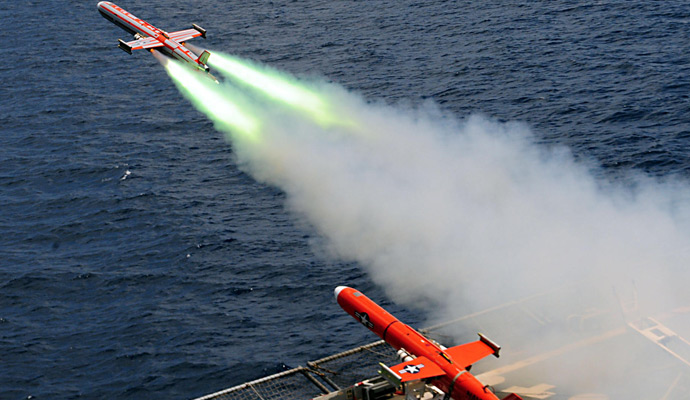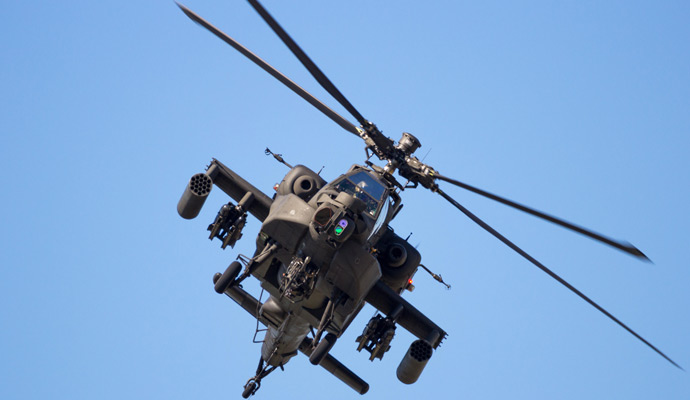Get Ready for the Silicon Military
As the global defense industry embraces digital technology, it is creating a new type of warfare with different winners and losers.
The defense sector is going through a rapid technological revolution. The digital tools it is adopting are changing the way the military operates and how countries will fight. Many of the companies involved in this revolution are not originally from the defense sector; they supply software and high-tech hardware in the civilian world as well. However, they now find themselves facing some of the same challenges that traditional arms manufacturers do — for example, challenges regarding relationships with governments and the protection of their own civilian staff. Meanwhile, countries that do not have major high-tech industries, and thus that cannot fully participate in the new defense revolution, could find themselves at a significant disadvantage. They may become the “have-nots” in the next generation of conventional warfare.
The catalyst for this wave of change is the adoption of digital technology by defense contractors in the U.S., Europe, China, and elsewhere. The same long-term industrial trends that are producing autonomous vehicles and Industry 4.0 in the civilian world are also involved in military research and development: automated large-scale manufacturing, connected devices (including the Internet of Things), and artificial intelligence (particularly when combined with robotics). One early manifestation is the increasing development of autonomous military machines, without people onboard controlling them. In the near future, robots and robotic infrastructure will be used more, even on large-scale platforms such as aircraft carriers. There is a laudable goal in this, which is taking soldiers out of harm’s way. As the saying goes, robots do not have widows or widowers. They also do not return from wars with disabilities, resentment, pension expectations, or political ambitions. Removing people from these military machines and platforms also offers immediate practical benefits; it means more space for fuel, parts, and ammunition.
However, as always with technology, the ultimate effects will not be evident until it matures. No matter how this new wave of military technology unfolds, its geopolitical and social implications could be as profound as those of a similar wave at the end of the 19th century. That was the peak of U.S., British, French, and German colonialism, when armies with vastly superior organization and new technology — such as dynamite, improved battleships, and reliable machine guns — conquered dozens of countries in Africa, Asia, and the Middle East. Franco-British writer Hilaire Belloc wrote in his 1898 poem “The Modern Traveller”: “Whatever happens, we have got / the Maxim gun, and they have not.” Today’s new technologies will not lead to a new wave of colonialization, but they could rapidly alter the geopolitical balance of power, by making some countries stronger and others more vulnerable. They will also create a new relationship between technology companies and military forces, which could deeply influence the kind of world we live in — making war safer for soldiers and more dangerous for programmers.
The Evolution of Military Technology
Efforts to create robotic war machines go back at least to the 1930s, when the Soviet Union prototyped a series of radio-controlled tanks called “teletanks,” with flame throwers and no people riding in them. Operationally, they were failures. Teletanks could only receive instructions, could not transmit information, and stopped when outside of radio range. Then, during World War II, the U.S. sought to fly remote-controlled bombers without success. As Londoners discovered, the Germans were more deadly with their V-1 flying bomb, which used a primitive gyroscope autopilot to time its descent.
The second stage of this military revolution began in the late 1980s, with the adoption of Silicon Valley–style technology. The U.S. has been flying its UAVs (short for “unmanned aerial vehicles”) since the 1990s for information gathering and since 2001 to attack ground targets. Most UAV missions are now flown by remote control, operated by pilots thousands of miles from their targets. These operators commute from home to war. Data connections and cybersecurity are now so good that these pilots could theoretically operate these platforms from their homes — which could make their dwellings into military targets. Indeed, in 2016 ISIS encouraged its followers to attack a list of U.S. drone pilots whose names and addresses the group distributed online.
The next wave of military technology will make war safer for soldiers but more dangerous for programmers.
The growth of digital technology has also affected military decision making. In addition to seeking “air superiority,” the upper hand in the skies, armed forces now also seek to attain “information superiority,” the upper hand in intelligence. As Haroon Sheikh, who heads the Strategy& Middle East defense and operations practices, argues, information superiority involves using more capable and faster systems for data gathering, analysis, information processing, and communications — to enable faster and better decision making than can be achieved by a country’s adversaries.
This ability to “get inside” an opponent’s decision cycle has long been a vital military advantage. The German advance in Greece in April 1941 was so fast that when the British sent a message to a regional headquarters of their Greek allies, the surprising message back was “This is the German army.” In recent conflicts, technology-driven information superiority has allowed U.S. forces to reduce casualties from friendly fire and greatly assisted operations against piracy off the Horn of Africa (pdf).
The digital military revolution seems relatively bloodless at first glance, because much of it is happening far from combat. Yet it has the potential to bring destruction to civilian areas, as 20th-century warfare did. Though World War II is remembered for the devastation it wrought on cities throughout Europe, the Western Allies largely focused on attacking military industrial and logistical targets, including marshalling yards, ports, ball bearing factories, and dams. The laws of war still maintain the central distinction between combatants and non-combatants, but new technologies do not necessarily recognize such a difference.
This ambiguity could lead opposing forces to treat some civilians as military targets. The organizations under lethal threat might include members of the digital supply chains that serve military companies: software development firms, coworking spaces, server farms, and big data companies. Shawn Brimley and Robert O. Work (the 32nd U.S. deputy secretary of defense) noted in their essay “20YY: Preparing for War in the Robotic Age” (Center for a New American Society, 2014) that “companies focused on producing consumer goods and business-to-business services are driving many other key enabling [military digital] technologies” (pdf).
These companies have so many other customers and clients that they often do not regard themselves as being in the defense business. However, in the same way that they are used to outsiders trying to hack their computer systems, they may face incidents in which their offices and staff are targets of drones or other attacks. War always involves killing.
Such companies will also face ethical and legal challenges that purely civilian companies do not have to deal with. To be sure, being at the forefront of the military digital revolution will be lucrative. However, such profits also come with costs, including liabilities and political entanglements that these companies must consider and plan for. For example, if its customers include countries with questionable military practices, a software company could be held responsible for the use of its products in violations of the laws of war, even to the level of war crimes. Arms manufacturers are used to legal and advocacy campaigns by human rights groups, especially when they sell weapons to autocratic regimes. All this will be new to many high-tech companies. Even those firms that seek to avoid these problems by refusing to sell their defense-applicable technology to the military could still encounter criticism — in this case, for being unpatriotic.
These digital companies therefore need to understand their limits and define their rules in advance. This will not be easy, because selling software is not like selling a howitzer. The army typically purchases this type of artillery outright; it owns it and is responsible for its misuse. For example, the manufacturer may be unaware that the army intends to use the howitzer to shell a town in which civilians live. By contrast, a software customer does not own the program outright; it licenses the use of the program. That works well for the buying organization, which receives continuous updates and support, and the selling company, which retains control of its intellectual property. However, it also links the software company tightly into the chain of responsibility. Some software providers may choose to surrender their intellectual property to avoid being held legally responsible for its results. That will limit their control over their intellectual property but may not excuse them from liability even so.
The dangers for software companies are exacerbated if customers include regimes that seek to control their citizenry. Even if a company tries to prevent this in the way it engineers its code, many militaries and security agencies have the ability to reengineer the code they buy. The implications go well beyond the types of privacy issues that affect consumers in relatively open countries. For example, many individuals provide data online that can easily be used to deduce, in a statistically reliable fashion, information about their ethnic or religious identity, that is, information that can make them into targets of state repression.
Changes in Military Practice
The new technologies will have similarly disruptive effects on practices and organizational structures within the military itself. For example, many armed forces insist that only officers can pilot aircraft or command squadrons of tanks. This is a tradition inherited from medieval armies, when cavalry ranks were composed of nobles whose families could afford a horse, armor, and the necessary retinue. For example, the most famous pilot of World War I, Manfred von Richthofen, was a German aristocrat who had been a cavalry officer. As late as 2015, the U.S. Air Force permitted only officers to operate drones; it relaxed those rules in 2016 only after it faced a pilot shortage.
In the coming era of artificial intelligence and autonomous platforms, however, this distinction between officers and enlisted soldiers will no longer make sense in the same way. Military academics have observed that although fewer and fewer young people in the U.S. know how to drive or even ride a bicycle, most of them have played enough video games to be intimately familiar with the concept of the new wave of aerial vehicles. The most effective drone-piloting prodigy of tomorrow might not even have completed high school.
The digital revolution is also affecting the deployment of larger-scale combat systems, such as tanks and aircraft carriers. These have long been core elements of military tactics. Robotics can allow them to become more efficient and effective while retaining the same functions and overall dimensions. Consider, for example, the tank, which is just over 100 years old. It is essentially a mobile, armored box for a cannon. It has a unique ability among land platforms to advance, control territory, and kill all kinds of ground adversaries. Without much modification, it can become autonomous and crewed by machines. An M1 Abrams tank with robot operators, for example, would have extra space to carry more ammunition plus additional fuel to increase its range beyond the current 265 miles. Robot tanks could “deep wade” a river without the need for a snorkel to sustain the crew.
But the robotic M1 Abrams would still have the same height, eight feet, as its human-controlled counterpart. It would be able to engage only one target at a time, and it would still fire six shells a minute. The next logical step would be a complete redesign of the tank around its functions, rather than around the crew or cannon. A robotic tank does not need a turret, nor a commander to look out of it, which saves on height. Whether tracked or wheeled, it could be armed with a cell of missiles similar to those already on U.S. Navy Arleigh Burke class destroyers. That would give it an arsenal that could hit tens of targets simultaneously. Close protection could be provided by machine guns whose bullets could be 3D printed on the spot. Data from the field would continually be sent to the factory. This would allow for improved operations and even for on-the-fly design improvements to the tank, more inexpensive and frequent than current military manufacturing can provide.
The military digital revolution will also blur the distinction between air, land, and sea platforms. Today, the ground units of advanced countries always conduct operations with support from satellites and UAVs, with manned platforms such as attack helicopters and fighter bombers intervening as needed. Tomorrow’s robotic tank will need similar support, but it could also carry its own small robotic boats to scout river crossings for hazards or small aerial vehicles to provide close-up reconnaissance. The robotic tank would not surrender or fall into an adversary’s possession — it would automatically destroy itself.
Implications and Unforeseen Consequences
Already the U.S. and other countries are considering the strategic, operational, tactical, and ethical implications of the military digital revolution. The U.S. is testing “centaur” teams composed of humans and machines as part of its “Third Offset” strategy to prepare for future robotically enabled warfare. In theory, the U.S. could have combat vehicles operating without people on board as early as 2021 (pdf). The U.S. is particularly worried that its main rivals, such as China and Russia, have easy access to military digital know-how, weakening its traditional technological superiority. In 2016, for example, Russia unveiled the Uran-9 Combat Robot, a light, remotely controlled tank. Other countries have patrol boats operating without people on board. The U.S., for its part, is testing “swarm boats” that can autonomously work together to defend or attack targets.
Among the countries at most disadvantage from this trend are emerging economies in the Middle East, Asia, Africa, and Latin America. Many do not even make the tanks into which they could put robots. Nor can they produce the robots, because they lack the necessary deep industrial, digital, and research capabilities. Some are also trapped with legacy systems that were cutting-edge a decade ago but will soon be redundant. For many of these countries, the cost of upgrading the military would be prohibitive.
Faced with that stark reality, these emerging economies may send human soldiers into combat against the next generation of robotic systems. These soldiers will not just be facing robotic tanks and autonomous drones; they will be facing a mix of intelligent technology, superior strategy, sophisticated operational craft, and tactics for combining all of these. Even with tactics such as suicide bombings and large-scale use of improvised explosive devices, it will be more difficult for smaller countries to prevail. All this could encourage a few of them to seek weapons of mass destruction as a means of compensating for their military weakness and to protect their independence.
For the more advanced powers, three issues will be critical: Can they deploy technology more effectively than their rivals? Can they safeguard their civilian populations — including those who work at high-tech companies that are now military contractors? Finally, can they do all this in a responsible way that allows them to retain their reputation as legitimate actors on the geopolitical stage?
The diplomatic world is just beginning to assimilate the implications of the emerging silicon military. There are already moves at the U.N., for example, to outlaw “killer robots.” Some advanced countries, including the U.K. and the U.S., are resisting those moves. An International Committee for Robot Arms Control has formed. More organizations, research, and protest activity will undoubtedly emerge.
The military digital revolution is changing the dynamics of warfare. It will continue to do so, creating a new ranking of power for companies that make the most effective autonomous and robotic weapons — and the countries that commission them. It is too early to say which companies and which countries those will be. That level of uncertainty is something the world has not experienced since the beginning of the Cold War. A new arms race, one of robotic, autonomous weaponry, is just starting. The robotic, connected, unmanned platform is the Maxim gun of the near future. Some will have it — and some will not.





